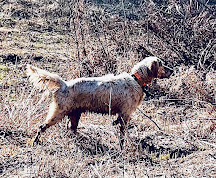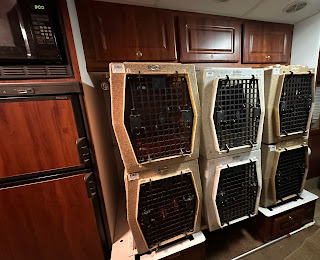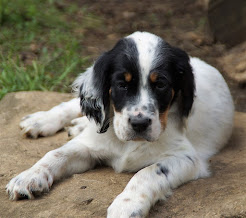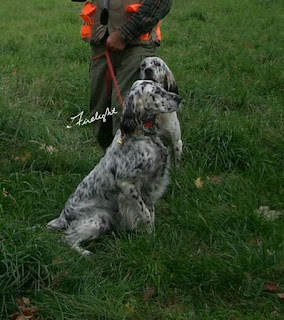"'There are two things got no place in this world," the Old Man said, "an old dog and an old man. They perform no useful function, and generally smell bad, too.'" - Robert Ruark, The Old Man and the Boy (1957).
Christmas is nigh, and we've just come in from the cold, Seth, Casper, and I. Like me, Seth needs more frequent comfort stops these days. Lately he summons me from his big orthopedic bed, first with a series of low whines, then an indignant yammering bark, a stodgy English lord ringing for the butler who never gets to his master's chambers quickly enough. Seth struggles to his feet while I put on my coat, his friend Casper, the terrorist terrier, dancing circles around us, taking up the conversation and reminding us that he needs to go out as well.
My great-grandfather's long strap of heavy sleigh bells hang inside the front door, our nod toward holiday decor. They jingle all our way out to the cluttered porch where Seth gathers himself before easing down into the yard to make his rounds - truck tire, garden trellis, the perennial bush I planted last spring, the one with the name I can't ever remember. Casper has already broken skim ice on the water bucket by the little garden cart. Seth joins him there for a long, loud drink.
I watch him there, tottery on an arthritic right stifle. He blithely ignores the cranky little dog growling his objections to sharing the bucket. I call them "Vincent" and "Julius" from the move Twins. Like Julius, the Danny DeVito character, Casper is the product of the streets, a cagey, cocky stray adopted by my aunt out of a big city shelter. Seth is Arnold Schwarzenegger as "Vincent," the trusting, easy-going himbo who is forever wondering why our entire pack can't just get along.
The sun is out, but there's a chill wind blowing, and I'm grateful for the heavy fleece jacket. If I don't chaperone, Seth will wander off, first to the pigeon loft to gaze up at birds loafing in their high aviary, then down into the barns just to see if there's a stray cat that needs pointing. I remember a sporting photographer telling me that whenever a shot of a "hot point" is needed and there're no game birds handy, nothing makes a dog stand taller than a grouchy cat crouching in a wire cage. The feral cats that ghost through our barns and loafing sheds won't hold, not even for a majestic, high-headed Seth point. When they slip away, the old dog shambles dejectedly back up to the house looking almost-but-not-quite-guilty. Seth can't hear much, so he's apt to stand and wag his tail as I scold, "What are we doin' here? Huh? Can you not just stick with the program of out-and-back-in?"
Today I am distracted putting some tools away. When I look up, Seth is dog gone. No faster than he walks these days, I know he's not far, and he's not - I find him trying to hoist himself up for a drink from the horses' water tank. He acts surprised to see me and follows as I turn for the house.
Casper is barking at the door. He is excited for his "We reported back like good dogs" treat from the big bag on the counter. He is already bouncing there before Seth and I can jinglejangle back through the door. An ear worm Christmas ditty twists into commentary on Seth's compromised gait: "Sleigh bells ring/Are you listing?" He gimps over to his own place near the treat bag, but lets Casper do the begging. Seth always trusts that I'll hold up my end of any bargain; Casper knows better. Unlike Seth, he keeps score, recalling every time he's ever been shorted by my geriatric ADHD.
The dogs settle in as I drop back into my desk chair. Holiday paper, scotch tape, and a pair of game shears, the only scissors I could find, are scattered on a low table by the desk. The last several presents needing wrapped are stacked off to the side. I check the football scores, go back into the kitchen to fetch the diet soda my doctor wants me to quit drinking, check messages to see if my friend Nick, hunting the last afternoon of our deer gun season, has a deer down and needs help. This behavior is my version of Seth's wayward cat stalks: anything to keep from getting back to my fumble-fingered wrapping.
I hear Seth muttering as he works at getting comfortable on his bed. We've both aged less than gracefully the past year. For me, it was pneumonia that lingered for weeks, then a total shoulder replacement on the right side followed by five months of therapy. For Seth, it's been the rise of arthritis in his right knee, the continued degradation of his hearing, as well as scattered incidents of what my vet calls "canine sundowner's," leaving him anxious and confused as the evening falls, sometimes through the night. The big orange dog and I huddle together during those spells, our proof that we're brave for each other. Always.
In full retreat from Christmas chores now, I turn on the computer and pull up Seth's photo file. I browse scenes from Seth's time here with me and before with Lynn Dee. The field portraits remind me that we're both retirees from Day Jobs we loved; I've never had a problem admitting that Seth was better at his than I ever was at mine.
Strong, athletic, smart, sensible, the unfailing team player, Seth went to his game with an edgy confidence that pinned birds and made the shooter's role easy. In his prime, he was fast and wide, confident and honest. When he finished with an alder tangle or deep, aspen choked swale, we moved on. Had there been a bird there, Seth would have been staunch downwind of it.
Woodcock hunting here in Ohio sometimes means punching into hells of saw briar, wild rose, and blackberry canes mean enough to test the toughest cordura field pants. Seth would pile into those nasty patches, especially as he learned springtime woocock would rest in their shelter. While I cringed, he'd bull through and come out the other end torn and bleeding, dog-smiling as if to say, "You, my man, know how to show a guy a good time!" Never once when the cover was tough or the day extra long did he quit, hunting the whole way back to the truck every single time, even this season, literally on his last legs.
Did he ever get the bit in his teeth? Sure. But it was never with the self-hunting belligerence I've endured with other setters and pointers. Seth was simply a determined dog with a lot of hunt, forever pushing cover. He worked with a conviction that if the birds weren't Right Here, then they'd certainly be Right Over There, and he'd prove it to me if I would only swallow the whistle and stay out of his way.
From Seth's file, I click on one for the pointer Moxie, another for Fancy Dancer and Riley, still others for the good Aspenglow setters I followed for so long, photos from 42 years of pointing dogs. There are the recent pics of Firelights Deacon and Luke, and finally Lynn Dee Galey's Spice, Seth's granddaughter that Lynn Dee now lets me trail behind, all the while marveling at her bred-in gifts, smitten by her bright, quirky ways.
It's the day after the Winter Solstice, and the night eases down like a slow curtain. I turn off the computer and pretend not to see the family gifts yet to be wrapped. Seth is stretched on his bed, breathing softly. He doesn't hear me as I step into the kitchen, nor does he stir when the jingle door ushers Casper and me out for late chores. We'll let sleeping Seths lie as we wrestle bags of dog food from the truck tailgate on to the porch and pour a bucket with kibble for the dogs who will eat outside.
Their food bowls filled, Luke, Deacon, and the Labrador Finn don't even lift their heads at hoofbeats from fast stepping Amish harness horses clopping down our asphalt road, hastening buttoned up buggies full of my good neighbors to Sunday vespers. Their church hall is north of the farm, and through the bare trees on my property line, I can see the glow of electric lanterns as men unhitch horses and lead them into the big barn parishioners built in a single day a couple of summers ago.
Seth is standing at the door when Casper and I have finished, and of course, the first thing he wants is out. I walk with him in the crisp December air, Venus already climbing the southwest sky. I can't deny the small ache inside as the big dog dodders around the yard. It seems like just the day before yesterday, he'd be an orange streak racing out into the hayfield to do his business, reluctantly trotting back up to the porch when I whistled.
The season has me especially aware that every day with Seth has been a gift that I didn't deserve, full of the same kind of color and wonder and belonging that is the best of how my family and friends celebrate Christmas and Hanukka. I like to think that every day Seth and I are together, we prove Robert Ruark wrong...at least the "function" part. Our "function" is not letting how we are physically this evening make us forget how we've been so many other days and nights, hunting hard and living well. My role is to remind him that everything's going to be alright. His is to model being brave.
Always.














































